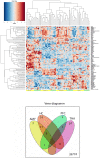Identification of transcriptome alterations in the prefrontal cortex, hippocampus, amygdala and hippocampus of suicide victims
- PMID: 34552157
- PMCID: PMC8458545
- DOI: 10.1038/s41598-021-98210-6
Identification of transcriptome alterations in the prefrontal cortex, hippocampus, amygdala and hippocampus of suicide victims
Abstract
Suicide is one of the leading causes of death globally for all ages, and as such presents a very serious problem for clinicians worldwide. However, the underlying neurobiological pathology remains to a large extent unknown. In order to address this gap, we have carried out a genome-wide investigation of the gene expression in the amygdala, hippocampus, prefrontal cortex and thalamus in post-mortem brain samples obtained from 20 suicide completers and 7 control subjects. By KEGG enrichment analysis indicated we identified novel clusters of downregulated pathways involved in antigen neutralization and autoimmune thyroid disease (amygdala, thalamus), decreased axonal plasticity in the hippocampus. Two upregulated pathways were involved in neuronal death in the hippocampus and olfactory transduction in the thalamus and the prefrontal cortex. Autoimmune thyroid disease pathway was downregulated only in females. Metabolic pathways involved in Notch signaling amino acid metabolism and unsaturated lipid synthesis were thalamus-specific. Suicide-associated changes in the expression of several genes and pseudogenes that point to various functional mechanisms possibly implicated in the pathology of suicide. Two genes (SNORA13 and RNU4-2) involved in RNA processing were common to all brain regions analyzed. Most of the identified gene expression changes were related to region-specific dysregulated manifestation of genetic and epigenetic mechanisms underlying neurodevelopmental disorders (SNORD114-10, SUSd1), motivation, addiction and motor disorders (CHRNA6), long-term depression (RAB3B), stress response, major depression and schizophrenia (GFAP), signal transduction at the neurovascular unit (NEXN) and inhibitory neurotransmission in spatial learning, neural plasticity (CALB2; CLIC6, ENPP1). Some of the differentially expressed genes were brain specific non-coding RNAs involved in the regulation of translation (SNORA13). One, (PARM1) is a potential oncogene and prognostic biomarker for colorectal cancer with no known function in the brain. Disturbed gene expression involved in antigen neutralization, autoimmunity, neural plasticity, stress response, signal transduction at the neurovascular unit, dysregulated nuclear RNA processing and translation and epigenetic imprinting signatures is associated with suicide and point to regulatory non-coding RNAs as potential targets of new drugs development.
© 2021. The Author(s).
Conflict of interest statement
The authors declare no competing interests.
Figures

References
-
- Scott KM, Hwang I, Chiu WT, Kessler RC, Sampson NA, Angermeyer M, Beautrais A, Borges G, Bruffaerts R, de Graaf R, Florescu S, Fukao A, Haro JM, Hu C, Kovess V, Levinson D, Posada-Villa J, Scocco P, Nock MK. Chronic physical conditions and their association with first onset of suicidal behavior in the world mental health surveys. Psychosom. Med. 2010;72(7):712–719. doi: 10.1097/PSY.0b013e3181e3333d. - DOI - PubMed
Publication types
MeSH terms
LinkOut - more resources
Full Text Sources
Miscellaneous

